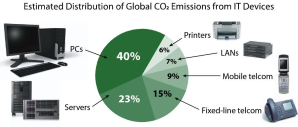One of the chief concerns among CIOs is finding energy efficient and economically efficient solutions with a rapid ROI and low TCO. I blog about energy efficient computing from the desktop to the data center, from hardware to software, from the network to the virtual cloud. Today I’m taking a look at solutions that are not sexy, but seem to work very efficiently and very economically.
Have you ever opened a new laptop or desktop fresh out of the box preloaded with tons of software you don’t need or ever use, and it can take up to 5 minutes for your PC to boot? Well, some unique companies have come up with a solution to get rid of that for you. Soluto, the Anti-Frustration Software, can help consumers for free. This free download can heal application crashes, lighten your web browser, and chop your boot time down significantly.
But let’s say you want to take that type of technology enterprise-wide, and that’s when you’ll want to take a look at Ziften Technologies’, Enterprise Efficiency Software solution. Imagine that boot problem on a large scale, or perhaps miscellaneous software running, but not being utilized. I call that software cholesterol, applications taking up resources, but not actually being used. According to Ziften, there is little to no focus on how to efficiently use resources on endpoints to achieve business goals.
How about enterprise energy management? In the past, IT Management and Facilities Management remained separated on this all important issue. One company, JouleX, has figured out a way to consolidate management of mechanical engineering and the total ICT infrastructure into one solution. JouleX allows you to generate reports, utilization, costs, savings and carbon emissions from data aggregated across your enterprise, data centers and facilities systems. You can reduce energy costs by monitoring, analyzing and controlling energy usage and utilization of all network connected devices and systems without the use of agents.
The least sexy software solution is PC Power Management. When it comes to Green ICT, I believe PC Power Management is the first solution you should try. I don’t care if it is Verdiem, 1E Corporation, BigFix, Faronics, or EnviProt everyone should start here. Why? Because you can reduce energy consumption by at least 40% by turning enterprise-wide PCs off evenings, weekends, or when they simply are not in use. This is the ultimate rapid return on investment with the lowest total cost of ownership, while running silently in the background. 1E Corporation seems to scale higher than most and they also provide server power management. While there are over 20 providers of PC Power Management, I will focus on a little known company called EnviProt. EnviProt got my attention based on their price point and a study they did at UC Berkeley. As far as I know, they have the lowest price point, but don’t quote me.
And last, but not least Green Printing Solutions. Would you like to reduce paper and toner usage? My personal favorite is Preton, which reduces toner usage by up to 70%, while maintaining print quality. In addition, it provides print management protocols and user/printer reports. The main reason it is my favorite is because of its pixel-optimizer technology. I’ve never seen anything like it, and I do not know of any other vendor coming close to it. Now I’ve been accused of sounding like all typical software salesman when I said, “I’ve never seen anything like it” but that’s the truth. I won’t mention any names, but it was a buyer at a prominent technology sales company from Canada that focused on Green IT Solutions, but either my delivery failed or the sex appeal of toner reducing software was just not potent enough to generate interest.
I’m not going to throw that company under the bus because I think they are an awesome company. But they are not alone. Preton was partially evaluated by the Federal Governments’ Green Products Compilation via NASA. Unfortunately they evaluated it without actually loading the software. Now I don’t know about you, but if you’re going to write a report about software, you may want to actually install it and use it. By the way, I never got a copy of the report.
Now I believe this technology is a game changer. Imagine reducing your toner budget by up to 70%. So I challenge anyone to prove me wrong. Find me a Green Printing Solution that comes close to Preton. Order a FREE Trial!
The solutions I have mentioned in this blog are not appearing to be sexy, but they are, and they get the job done. Most of these solutions have been tried out by reputable companies, but have been shoved to the side by more strategic projects like desktop virtualization, data center consolidation, and cloud computing. While those strategic projects are important, except for cloud computing, they are very costly to implement. To me, the low hanging fruit is sexy.
So once you finish those costly projects use the savings to go unsexy with energy efficient software solutions for the enterprise. Contrary to popular belief, there are more efficiency opportunities throughout the desktop enterprise than there is in the data center.


















